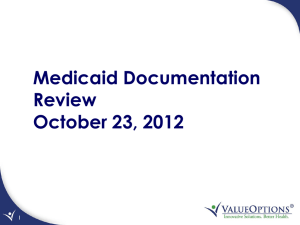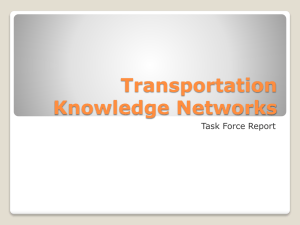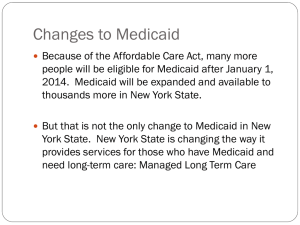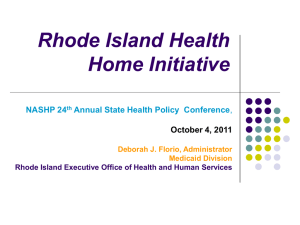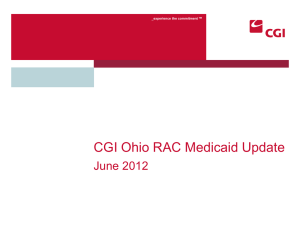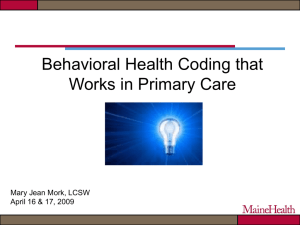Medicaid RACs - Jackson Walker LLP
advertisement
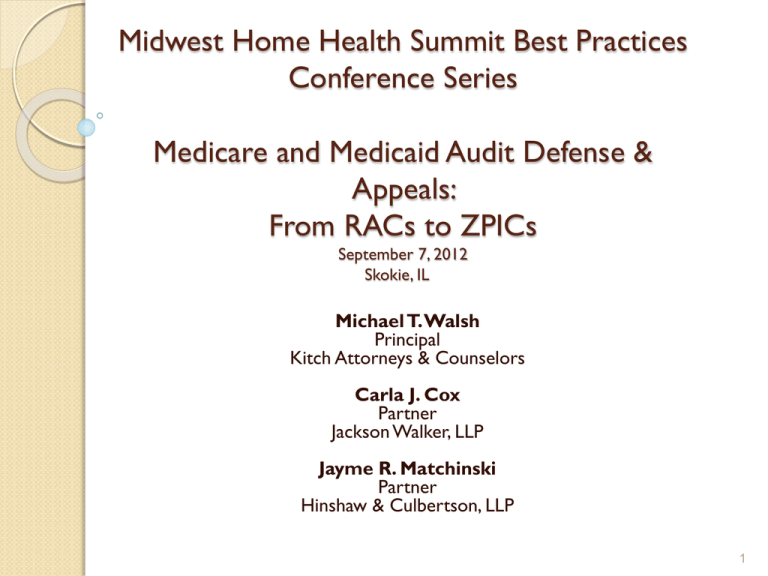
Midwest Home Health Summit Best Practices Conference Series Medicare and Medicaid Audit Defense & Appeals: From RACs to ZPICs September 7, 2012 Skokie, IL Michael T. Walsh Principal Kitch Attorneys & Counselors Carla J. Cox Partner Jackson Walker, LLP Jayme R. Matchinski Partner Hinshaw & Culbertson, LLP 1 Disclaimer These materials have been prepared for informational purposes only and are not legal advice. This information is not intended to create, and receipt of it does not constitute, an attorney-client relationship. Readers should not act upon this information without seeking professional counsel. Photographs, articles, records, pleadings, etc., are for dramatization purposes only. 2 Acronyms RAC—Recovery Audit Contractors CERT—Comprehensive Error Rate Testing ZPIC—Zone Program Integrity Contractors PSC—Program Safeguard Contractors MAC—Medicare-Administrative Contractors ADR – Additional Documentation Request MIC – Medicaid Integrity Contractors 3 MEDICARE V. MEDICAID AUDITS MEDICARE AUDITS MEDICAID AUDITS Medicare Recovery Audit Contractors (RACs) Medicaid Recovery Audit Contractors (RACs) Zone Program Integrity Contractors (ZPICs) Medicaid Integrity Contractors (MICs) Program Safeguard Contractors (PSCs) State of Illinois Healthcare and Family Services Office of Inspector General Medicare Administrative Contractor (MACs) Illinois State Police Medicaid Fraud Control Unit 4 RECOVERY AUDIT CONTRACTOR PROGRAM 5 The Recovery Audit Contractor Program Recovery Audit Contractors (RACs) are charged with identifying and recouping improper payments under Medicare Parts A and B 6 Background of the RAC Program The Medicare Recovery Audit Contractor Program began as a demonstration program to identify Medicare overpayments and underpayments to health care providers and suppliers in California , Florida , New York , Massachusetts , South Carolina, and Arizona. The demonstration program resulted in nearly $1 billion returned to the Medicare Trust Fund and approximately $38 million in underpayments returned to providers. 7 Demonstration Program RACs are paid a contingency fee based on the amount of collected repayments Fee may be as high as 12.5% The RACs made $187.2 million in contingency fees during the demonstration program The demonstration program proved to be cost effective for CMS 8 Permanent Program Due to the success of the demonstration program, Congress required a permanent and national RAC program to be in place by 2010, under the Tax Relief and Health Care Act of 2006 The Affordable Care Act expanded the RAC program to cover Medicare Parts C and D ◦ Medicare Advantage ◦ Medicare Prescription Drug 9 Who are the Medicare Recovery Audit Contractors? Four Contractors, each for one of the four regions ◦ Region A Diversified Collection Services, Inc. ◦ Region B CGI Technologies and Solutions, Inc. ◦ Region C Connolly, Inc. ◦ Region D HealthDataInsights, Inc. 10 Illinois’ Medicare RAC CGI Technologies and Solutions, Inc. Email: racb@cgi.com Phone: 1-877-316-RACB (7222) CGI FEDERAL, Medicare RAC Region B Website, Region Map, http://racb.cgi.com/RACRegionBMap.aspx 11 Getting Prepared What preparation is necessary? Should the RAC be contacted prophylactically? What needs to be done internally? Do Self-Audits have a place? What education steps should be taken? What happens if an overpayment is discovered in a self-audit? 12 RAC Claims Review Improper claims will be identified in four areas: 1. Payments made for services that were not medically necessary or that were provided in a setting that was not necessary 2. Payments made for services that were not correctly coded 3. Payments made where there is not enough documentation to support the claim 4. Payments made involving other errors 13 What are RACs looking at currently? All issues reviewed by the RAC must go through a CMS approval process. Once approved by CMS, all areas the RAC intends to review must be posted on its website prior to widespread review The RACs will use their own proprietary software and data-mining systems as well as their knowledge of Medicare rules and regulations to determine what areas to review. 14 THE FOCUS OF CURRENT RAC AUDITS Home Health RAC Approved Issues Region C: Incorrect Billing of Home Health Partial Episode Payment Claims ◦ States affected: AL, AK, CO, FL, GA, LA, MS, NM, NC, OK, Puerto Rico, SC, TN, TX,Virgin Islands,VA, WV ◦ Description: Incorrect billing of Home Health Partial Episode Payment (PEP) claims identified with a discharge status 06 and another home health claim was not billed within 60 days of the claim from date. Additionally, MCO effective dates are not within 60 days of the PEP claim. ◦ No issues approved for home health for Region B 15 The Audit Process RACs are permitted to review claims limited to a three-year look-back period RACs are not allowed to review the following claims: ◦ Issues not approved by CMS ◦ Claims previously reviewed by another Medicare contractor ◦ Claims involved in potential fraud investigation ◦ Claims submitted before October 1, 2007 ◦ Claims involved in Medicare demonstration programs or that have other special processing rules 16 The Audit Process How do RACs identify overpayments? How will RACs obtain medical records for review and how will audit results be communicated? What policies and articles do RACs use when reviewing claims for improper payments? 17 After the Audit What is the appeals process? When should an appeal be made? If an overpayment is identified under Medicare Part A, can the claim be resubmitted for coverage under Part B? 18 RAC Process CGI FEDERAL, Medicare RAC Region B Website, RAC Process Flowchart, http://racb.cgi.com/Docs/Rac%20Process%20Flowchart.pdf 19 20 21 Keys for a Successful RAC Appeal Scan and save all documents in electronic format. Make records readily available. Resubmit records / documentation and highlight pertinent sections. Use technology to review successful appeals. Re-evaluate your decision to appeal at each level of appeal. 22 Steps That Home Health Agencies Should Consider Prior to Receiving a RAC Audit Letter Educate and Train Staff. Provide staff with the right tools to ensure accurate and proper claims coding. It is imperative that everyone involved in the submission of a Medicare claim understand the RAC program. Develop a RAC Compliance Plan. Home Health Agencies should have a written RAC plan that addresses RAC compliance issues, education efforts and reviews. Designate a RAC Response Team and Team Leader. This team should consist of medical, compliance, coding and billing personnel. Providers have 45 days from the date of the initial RAC audit letter to submit a response. 23 Steps That Home Health Agencies Should Consider Prior to Receiving a RAC Audit Letter (Con’t.) Conduct Chart Reviews and Internal Audits. Review your compliance programs and make any necessary modifications. Home Health Agencies should schedule and conduct frequent reviews of issues such as compliance with CMS coverage criteria, local coverage determinations, coding, billing and coverage, utilization, and patient documentation requirements. Utilize Tracking and Reporting Systems. Home Health Agencies should consider using tracking and reporting systems to manage the process and analyze audit patterns. Tracking deadlines, pending requests, RAC determinations, and appeal status enables the lab to manage the process and analyze and adjust documentation as necessary. 24 Steps That Home Health Agencies Should Consider Prior to Receiving a RAC Audit Letter (Con’t.) Develop Corrective Plans of Action. For any issues where issues currently exist or where the likelihood of noncompliance is high, develop and document plans of action to correct the deficiencies. Monitor the Trends and Enforcement in Your RAC Region. While the RAC auditors can review any of the approved issues for your region, regularly check your region’s RAC contractor’s website for updated information regarding recent activity and collection efforts. 25 Steps That Home Health Agencies Should Consider Prior to Receiving a RAC Audit Letter (Con’t.) Involve Your Legal Counsel During the Early Stages of the Planning Phase. The RAC auditing process is complicated and multi-faceted. Including legal counsel prior to an actual audit can be beneficial in determining areas of potential liability and steps to be taken during the audit process and future appeals. 26 New Recovery Audit Prepayment Review Demonstration CMS will now be piloting using Recovery Auditors to increase the number of prepayment reviews performed Does not replace Medicare Administrative Contractor prepayment reviews RACs will coordinate with other contractors to review vulnerable areas of the Medicare Program in order to limit improper payments or fraud 27 RAC Prepayment Review Program August 27, 2012 – August 26, 2015 Applicable to 11 states, including Illinois ◦ fraud and error-prone ◦ high volume of inpatient stays Prepayment reviews rather than “pay and chase” approach ADRs will come from FI/MAC Providers will have 30 days to send in documentation 28 Medicaid RAC Program Section 6411 of the Affordable Care Act of 2010 also expanded the RAC program by requiring states to establish Medicaid RAC programs Medicaid RACs ◦ ◦ ◦ Identify payment errors State issues Not audit claims that have been or currently being audited States afforded flexibility in the design and operation of Medicaid RAC programs 29 Illinois’ Medicaid RAC Under Federal Regulation, Medicaid programs are required to contract with one or more Recovery Audit Contractors to identify underpayments and overpayments and recoup overpayments under the Medicaid program. There are two bidders from Illinois’ Medicaid RAC: Optum or Health Management Systems 30 Medicare RACs v. Medicaid RACs Key differences: ◦ ◦ ◦ ◦ Funding Authorization of the RAC programs Control over the RAC programs Medicaid RAC Final Rule: focused on flexibility for states 31 Medicaid RACs February 1, 2011: CMS Bulletin September 16, 2011: CMS publishes Final Rule January 1, 2012: States required to have implemented their Medicaid RAC programs ◦ Clarified that states will not be required to implement their RAC programs by the proposed implementation date of April 1, 2011. ◦ Previous Bulletin (issued October 1, 2010) and Proposed Rule (issued November 10, 2010) called for state programs to be fully implemented by April 1, 2011(absent an exception) 32 Medicaid RACs Medicaid RAC Final Rule Eligibility requirements for Medicaid RACs ◦ Entity must display to the state that it has the technical capability to carry out the Medicaid RAC tasks. Examination of entity’s trained medical professionals in good standing with state licensing authorities ◦ Entity must hire or maintain a minimum of 1.0 full-time equivalent Contractor Medical Directors who is either a M.D. or a D.O. in good standing with licensing authorities and has experience in relevant work. ◦ Entity must hire certified coders unless the state determines that this is not necessary. 33 Medicaid RACs The Final Rule does not require states to provide coding/billing guidelines to providers. ◦ Will this omission hinder proactive compliance efforts? ◦ Possible defenses as a result of no coding/billing guidelines? The Final Rule does require Medicaid RACs to provide minimum customer service measures and to not audit claims that have already been or are currently being audited. ◦ No specific mechanism was imposed on the states to prevent duplication of efforts. ◦ Will states use a Data Warehouse technique? 34 Medicaid RACs Funding ◦ States’ costs to carry out the Medicaid RAC program (establish, operate and appeals process) will be shared by the federal government at the 50% administrative rate applied to all Medicaid expenditures. ◦ States are required to determine the contingency fee rate to be paid to Medicaid RACs. Must not exceed the highest contingency rate set paid in the Medicare RAC program (currently 12.50%). Anything in excess will be paid using state-only funds. 35 Medicaid RACs Scope of Medicaid RAC Audits ◦ CMS will not issue oversight provisions regarding medical necessity reviews for the Medicaid RAC program. Medicaid RAC medical necessity reviews will be performed within the scope of state laws and regulations. ◦ CMS will encourage states to form review teams for Medicaid RACs similar to the Medicare RAC program’s “New Issue Review Board.” ◦ Absent from the Final Rule: a requirement that states require advanced approval of medical necessity reviews. 36 Medicaid RACs Post-Medicaid RAC Audit – Re-Billing a Claim: States have discretion whether to allow claims to be rebilled and the requirements for re-filing, consistent with state law, regulation and policy. – Medicaid RACs Reopening Claims State discretion: states have different administrative appeal processes, thus CMS will not require states to comply with the reopening regulations as set forth in the Medicare RAC program. – Collection of overpayments RAC contingency fee based on the overpayments recovered, rather than those simply identified.19 37 Medicaid RACs Post-Medicaid RAC Audit (continued) – Collection of over payments RAC contingency fee based on the overpayments recovered, rather than those simply identified. A state may pay the contractor once the overpayment is identified and recovered, regardless of any subsequent provider appeal, but if the provider is successful during the appeals process the contractor must return the applicable portion of the contingency fee. A state may also choose to pay the RAC its contingency fee after any and all provider appeals are fully adjudicated. 38 Medicaid RACs Impact of Medicaid RACs ◦ In the Final Rule CMS estimated that in 2012 the Medicaid RAC program will save the federal government $60 million and state governments $50 million. ◦ Aggregate net savings of $2.13 billion for FYs 2012 through 2016. ◦ The Final rule did not project any expected impacts of the Medicaid RAC program on Medicaid healthcare providers. 39 Medicaid Integrity Program v. Medicaid RACs Medicaid RAC final rule strongly asserted that the program is different from the MIP: – Role/Purpose RACs: identify payment errors; state issues MICs: identify and prevent fraudulent practices; regional/federal issues – Organization Medicaid Integrity Program (“MIP”): has three types of contractors. MICs are federal contractors and organized regionally – MICs are not paid on a contingency fee 40 ZONE PROGRAM INTEGRITY CONTRACTORS 41 Zone Program Integrity Contractors Zone Program Integrity Contractors (ZPICs) replaced Program Safeguard Contractors ZPICs ◦ identify improper billing patterns that indicate potential fraud, waste, and abuse; ◦ investigate cases of suspected fraud; and ◦ refer cases to OIG for further investigation. 42 In general, ZPICs Identify potential fraud, waste, and abuse Conduct audits of all claims (pre- and post- pay audits) Purposefully select providers to audit May show up at your building In general, RACs Identify overpayments Conduct post-pay audits Randomly audit providers Requests records ZPIC vs. RAC: What’s the Difference? 43 How do ZPICs find cases of fraud, waste and abuse? Proprietary software to look at claims data (fiscal intermediary, regional home health intermediary, carrier, and durable medical equipment regional carrier data) and other data. By combining data from various sources, the ZPIC can then present an entire picture of a beneficiary's claim history regardless of where the claim was processed. The primary source of this data will be the CMS National Claims History (NCH). 44 ZPIC Background The Health Insurance Portability and Accountability Act (HIPAA) established the Medicare Integrity Program (MIP) MIP allowed CMS to develop program safeguard functions, including the creation of the Program Safeguard Contractors (PSCs) entity PSCs purpose was to perform these program integrity functions 45 Background Then, the Medicare Modernization Act required CMS to use a uniform administrative entity, instead of the fiscal intermediaries and carriers being used This uniform type of administrative entity is known as Medicare Administrative Contractors (MACs) Seven program integrity zones were created based on the MAC jurisdictions Zone Program Integrity Contractors were created to perform program integrity in these zones 46 ZPIC Zones Zone 1 ◦ Safeguard Services Zone 2 ◦ AdvanceMed Zone 3 ◦ Cahaba Safeguard Administrators Zone 4 ◦ Health Integrity Zone 5 ◦ AdvanceMed Zone 6 ◦ To Be Determined (under protest) The ZPICs perform program integrity functions in these zones for: ◦ Medicare Parts A & B ◦ Potentially Medicare Parts C & D by assuming some of the work of the Medicare Drug Integrity Contractors (MEDIC) ◦ Durable Medical Equipment Prosthetics Orthotics Supplies ◦ Home Health and Hospice ◦ Medicare-Medicaid data matching Zone 7 ◦ Safeguard Services 47 Illinois’ ZPIC Zone 3 Minnesota, Wisconsin, Illinois, Indiana, Michigan, Ohio, Kentucky Cahaba Safeguard Administrators Email: info@csallc.com Phone: (205) 220-4802 48 Overview of ZPIC Functions Reactive and Proactive identification of potential fraud, waste and abuse Investigating potential fraud and abuse for CMS administrative action Identifying the need for administrative actions such as payment suspensions and prepayment or auto-denial edits Referring cases to law enforcement for consideration and initiation of civil or criminal prosecution 49 Potential Fraud Allegations of fraud made by beneficiaries, providers, CMS, Office of Inspector General, and other sources Upon receiving an allegation of fraud, or identify a potentially fraudulent situation, ZPICs shall investigate to determine the facts and the magnitude of the alleged fraud ZPICs will also conduct a variety of reviews to determine the appropriateness of payments, even when there is no evidence of fraud 50 Medicare Fraud Examples Incorrect reporting of diagnoses to maximize payments Participating in anti-kickback schemes ◦ i.e. kickbacks from ambulance companies to nursing facilities “Gang visits” ◦ Physician visits a nursing facility and bills for 20 visits without furnishing any specific service to individual patients Misrepresentations of dates and descriptions of services furnished or the identify of the beneficiary or the individual who furnished the services 51 Investigation Investigation is the analysis performed on both proactive and reactive leads in an effort to substantiate the lead or allegation as a case ZPICs use a variety of investigative methods Requests for medical records and documentation Onsite visits ◦ Announced ◦ Unannounced Interviews 52 Investigation: Record Review Data analysis Identification of deviations in billing patterns within a homogeneous group Identification of patterns within claims or groups of claims that might suggest improper billing or payment 53 Not ZPIC Functions Claims processing, including paying providers Provider outreach and education Recouping monies Medical review that is not for benefit integrity purposes Complaint screening Claims appeals of ZPIC decisions Claim payment determination Claims pricing; and Auditing provider cost reports 54 ZPIC Actions ZPICs initiate appropriate administrative actions to deny or suspend payments that should not be made to providers ZPICs initiate overpayment recovery actions ◦ Medicare Administrative Contractors issue demand letters and recoup the overpayments 55 Referral Actions ZPICs refer cases to the Office of Inspector General or Office of Investigations for consideration of civil and criminal prosecution and/or application of administrative sanctions ZPICs refer any necessary provider and beneficiary outreach to the provider outreach and education staff at the MAC 56 Appeals Should a provider elect to appeal a claim reviewed by a ZPIC, the ZPIC will forward its records to the Medicare Administrative Contractor 57 MEDICAID INTEGRITY CONTRACTORS (MICS) 58 Medicaid Integrity Contractors (MICs) Managed at the state level 3 types of MIC: - Review contractors - Audit contractors - Education contractors 5 jurisdictions (2 CMS regions per) Use data mining to identify high-risk areas Focus on extreme outlier providers 59 Medicaid Integrity Contractors Hired contractors to review Medicaid provider activities, audit claims, identify overpayments, and educate providers and others on Medicaid program integrity issues Provide effective support and assistance to States in their efforts to combat Medicaid provider fraud and abuse By the end of FY2010, 947 audits were underway in 25 states and MIG efforts had identified an estimated $10.7 million in overpayments. Medicaid Integrity Report to Congress, 2010 60 Medicaid Integrity Contractors Section 6034(e)(3) of the Deficit Reduction Act 2005 mandated the creation of the Medicaid Integrity Program (MIP) ◦ Under MIP, CMS hires contractors to review Medicaid provider activities, audit claims, identify overpayments, and educate providers on Medicaid program integrity issues ◦ CMS will support and assist the states in their efforts to combat Medicaid fraud and abuse MIP is operated under the jurisdiction of the Center for Medicaid & State Operations (CMSO) 61 MIC Target Areas Duplicate billing Services after death Non-covered services Medically unnecessary services Outpatient billing during inpatient stay Never events 62 MIC Specifics No limit on number of medical records that can be requested No limit on look-back period Compensation of MICs not based on contingency fee 63 Medicaid Integrity Contractors Review MICs ◦ Review and select providers for audits with a 5 year look back period Audit MICs: Request for Records & Documentation of Findings ◦ 30 days to provide records ◦ All audit findings must be supported by adequate documentation 64 Medicaid Integrity Contractors Audit MICs: Audit Report Process ◦ Audit MIC sends provider a notification letter. ◦ If the Audit MIC believes that an overpayment exists, it will prepare a draft report which will be reviewed by the provider and the state. ◦ The provider has an opportunity to comment on the report. ◦ CMS prepares a second draft report, then finalizes the report and sends it to the state. ◦ The state pursues collection of the overpayment from the provider. 65 Medicaid Integrity Contractors Audit MICs ◦ Audit MICs are not tasked with collecting overpayments ◦ Federal government collects its share directly from the state and the state is responsible for recovering the overpayment from the provider ◦ Like the RAC program, payments to providers may be recouped once an overpayment is identified. Not so fast... 66 Medicaid Integrity Contractors MIC Fraud Referrals ◦ If an Audit MIC identifies potential Medicare or Medicaid fraud, it must simultaneously and immediately make a fraud referral to the Medicaid Integrity Group (MIG) or the Office of Inspector General for the Department of Health and Human Services (OIG). Medicaid Program Integrity Manual, 100-15, Ch. 10 § 10020. ◦ The OIG has 60 days to determine whether to accept the referral. 67 Medicare Administrative Contractors (MACs) Pursuant to Medicare Prescription Drug, Improvement and Modernization Act of 2003, CMS is transitioning and consolidating the roles of intermediaries and carriers into MACs MACs are assuming all functions of the current intermediaries and carriers Provider services will be simplified by having a single MAC process both its Part A and Part B claims 68 Important Aspects of Home Health Medicare Compliance: Face-to-Face Requirements The Patient Protection and Affordable Care Act (PPACA) implemented face-to-face requirements for home health and hospice providers. Home Health: the certifying physician must document that s/he or a non-physician practitioner working with the physician has seen the patient within 90 days prior to the start of care or within 30 days after the start of care. 69 Additional Key Audit Risk Issues for Home Health Homebound Skilled services Physician certification Performance of services that were not ordered Expectation of improvement: hindsight standard 70 Effective Home Health Compliance Measures Objectively review documentation practices to verify compliance with Face-to-Face Documentation and Terminal Illness Certification Requirements. Establish proactive protocols for reviewing cases: ◦ Documentation enhancement ◦ Periodically review policies ◦ Implement monitoring protocols 71 Michael T. Walsh Kitch Attorneys & Counselors M.Walsh@kitch.com (312)332-7901 Carla J. Cox Jackson Walker, LLP CJCox@jw.com (512)236-2000 Jayme R. Matchinski Hinshaw & Culbertson, LLP JMatchinski@hinshawlaw.com (312)704- 3000 72

